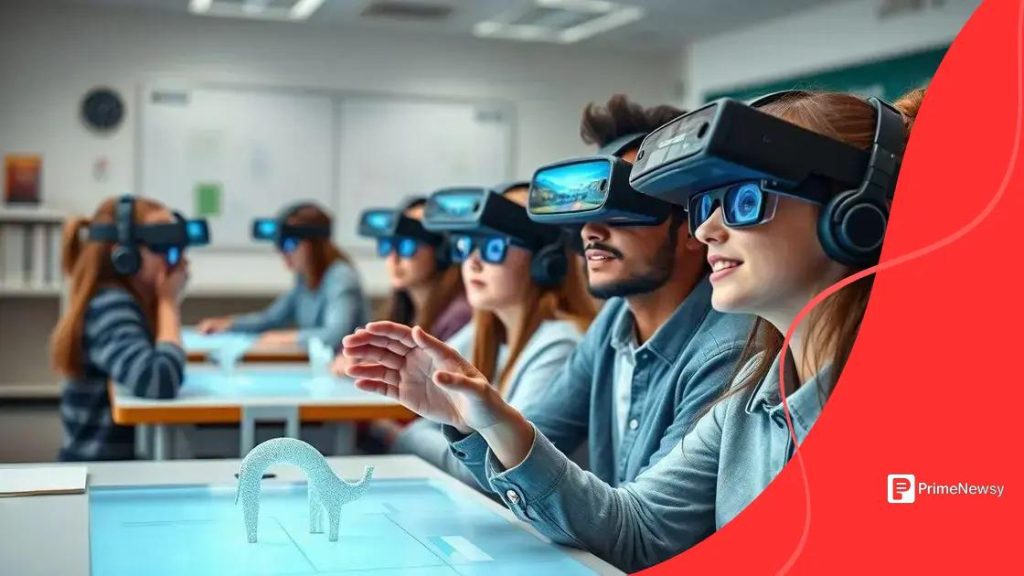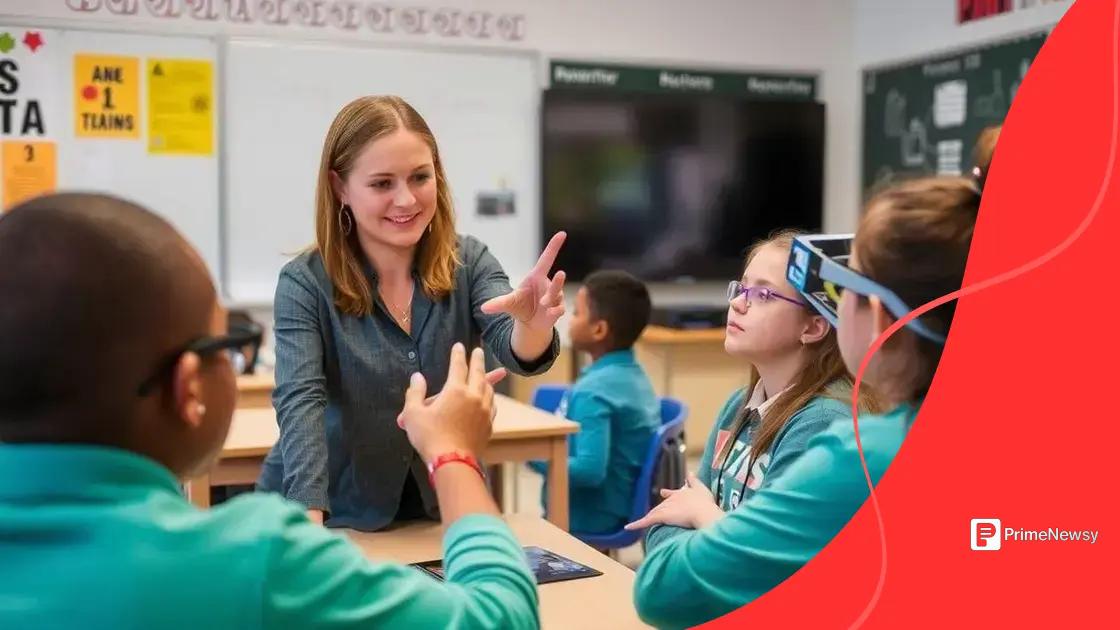Using AR to enhance learning in classrooms

Anúncios
Using AR to enhance learning in classrooms transforms education by increasing student engagement, improving retention of information, and providing interactive experiences across various subjects.
Using AR to enhance learning in classrooms is changing how students experience education. Imagine a world where historical events come to life or complex science concepts can be visualized right in front of you. Could this be the future of learning?
Anúncios
what is augmented reality in education?
Augmented reality (AR) in education refers to the integration of digital information with the real world, creating an interactive learning experience. This technology allows students to engage with material in a dynamic way, transforming traditional lessons into immersive activities.
With AR, learners can visualize complex concepts, making them easier to understand. For example, 1st grade science lessons can include 3D models of animals, while history students might explore ancient civilizations through virtual tours. This enhances their grasp of the subject by seeing it firsthand.
Benefits of AR in Education
Using augmented reality introduces a variety of benefits in learning environments.
Anúncios
- Increased engagement among students.
- Enhanced retention of information.
- Opportunities for hands-on learning experiences.
- Support for diverse learning styles.
Another compelling aspect of AR is its ability to foster collaboration. Students can work together on AR projects, encouraging teamwork and communication. They can explore topics together and present what they’ve learned in creative ways.
Moreover, AR creates a bridge between theory and practice. For instance, in math classes, students can visualize geometric shapes in 3D, helping them understand spatial relationships.
Many educators are already harnessing augmented reality to create innovative lessons. Tools like AR apps allow teachers to build rich, interactive assignments. Schools can create their own AR content to suit their curriculum, ensuring a tailored approach to education.
As technology continues to evolve, the potential for AR in education expands. It encourages researchers and developers to create even more engaging experiences for students.
the benefits of using ar in classrooms
Using augmented reality (AR) in classrooms offers a range of exciting benefits that enhance the learning experience. Students are more engaged when lessons include interactive elements supported by AR technology. This engagement can lead to a better understanding of complex subjects.
Enhanced Engagement
One of the main advantages of AR is its ability to capture students’ attention. Traditional teaching methods can sometimes feel monotonous, but with AR, lessons become lively and memorable. Students can explore subjects like science and history in ways that spark their curiosity.
- Interactive experiences increase student motivation.
- Visualization of difficult concepts makes learning easier.
- Active participation leads to deeper understanding.
Additionally, using AR fosters collaboration in the classroom. Students can work together on projects that involve AR, enhancing their teamwork skills. The technology provides platforms for students to share ideas and create together, all while immersed in the learning material.
Improved Retention of Information
Research shows that when students interact with physical and digital content through AR, they retain information better. This improved retention is essential for academic success.
For example, when students visualize a 3D model of the solar system, they can remember details about each planet more effectively. The engaging nature of AR helps solidify knowledge that might otherwise be forgotten.
Furthermore, AR supports various learning styles. Visual learners benefit from seeing graphics and animations, while kinesthetic learners engage with hands-on activities. This versatility ensures that all students have the opportunity to learn in a way that suits them best.
Introducing AR in classrooms not only benefits students but also helps teachers. It allows educators to create more dynamic lesson plans and incorporate technology into their teaching. As teachers explore AR tools, they can find innovative ways to present information and assess understanding.
how to implement ar tools effectively

Implementing augmented reality (AR) tools effectively in the classroom requires careful planning and a clear strategy. Educators need to consider several factors to maximize the benefits of this innovative technology.
Choosing the Right AR Tools
It’s essential to start by selecting the right AR tools that align with your curriculum goals. There are various apps and platforms available, each with unique features. Research is important to find resources that cater to the specific needs of your students.
- Look for tools that support different subjects.
- Ensure the technology is user-friendly for both students and teachers.
- Check for compatibility with existing devices.
Once you have identified suitable tools, training is the next step. Educators should participate in professional development sessions to become familiar with the AR technology and its applications in the classroom.
Integrating AR into Lesson Plans
Integrating AR effectively into lesson plans takes creativity and flexibility. Teachers can start by incorporating AR activities gradually, engaging students in hands-on projects that complement the learning material. For instance, science teachers can use AR to demonstrate complex chemical reactions, making them visually accessible and interactive.
Working collaboratively is another key aspect. Encourage students to share their thoughts and experiences with AR activities. This collaborative approach helps reinforce learning and supports critical thinking. Make sure to gather feedback from students about the AR tools being used, which can direct future implementations.
Regular assessments and evaluations should be part of the process as well. Teachers can adjust their AR strategies based on how effectively students are meeting learning objectives. By doing so, they ensure that AR tools are enhancing the educational experience.
Moreover, creating a supportive environment plays a significant role. Educators should foster a positive atmosphere where students feel comfortable experimenting with AR technology. This support boosts confidence and encourages students to explore new concepts without fear of failure.
real-world examples of ar in education
Real-world examples of augmented reality (AR) in education showcase the power of this technology in transforming learning experiences. Schools and institutions around the world are embracing AR, providing students with interactive and immersive lessons.
Medical Training
One impressive example can be found in medical training. Schools have started to use AR to teach anatomy. With AR applications, students can visualize human organs in 3D, allowing them to explore complex systems without the need for cadavers. This hands-on experience enhances their understanding of biology and anatomy.
History Lessons
Another great application is in history lessons. Some classrooms use AR apps to recreate historical events. For instance, students can see a 3D representation of the Great Wall of China or participate in a virtual tour of ancient Rome. These immersive experiences make history come alive, making it more engaging and relatable.
- Students can interact with historical figures.
- Explore significant battles in a 3D environment.
- Learn about the culture and society of the time.
Additionally, AR is utilized in geography lessons. By using AR, students can visualize geography concepts like topography and climate patterns. They can see dynamic maps that change based on different data points, which helps them understand global issues more effectively.
STEM Education
In STEM (Science, Technology, Engineering, and Mathematics) education, AR tools facilitate complex problem-solving. For instance, students can use AR to build virtual models in engineering classes, allowing them to experiment with designs and see how they perform under different conditions.
Furthermore, math classes benefit from AR, as students can manipulate and visualize equations and geometric shapes in a three-dimensional space. This enhances their understanding of spatial relationships and abstract concepts that are usually challenging to comprehend.
Several universities are also using AR for language learning. Students can engage with vocabulary in real-world contexts through AR applications, which helps reinforce language skills in an interactive manner.
challenges and solutions to ar integration
Integrating augmented reality (AR) into education comes with its own set of challenges. Understanding these obstacles and exploring potential solutions is crucial for effective implementation in classrooms.
Technical Limitations
One significant challenge is the technical limitations of devices and software. Not all schools have access to high-quality AR tools or devices that support AR technology, which can hinder its effectiveness.
- Budget constraints may prevent schools from obtaining the latest devices.
- Inconsistent internet connectivity can disrupt AR experiences.
- Teachers may require adequate training to use AR tools effectively.
To address these issues, schools can seek partnerships with technology companies that provide AR tools. Grants and funding opportunities can help offset costs, allowing for better access to necessary resources.
Curriculum Integration
Another challenge is the integration of AR into existing curricula. Teachers might struggle to find ways to seamlessly incorporate AR into their lesson plans without overwhelming students or deviating from learning objectives.
To overcome this hurdle, educators can collaborate and share successful strategies. Developing a library of AR resources tailored to different subjects can ease the planning process. This encourages cross-curricular projects that enhance learning through collaboration and creativity.
Furthermore, educators can start small by incorporating AR in specific lessons before expanding its use. This gradual approach allows teachers to assess what works best for their students while adjusting lessons accordingly.
Student Management
Managing student engagement while using AR tools can present challenges. Some students may become distracted or lose focus when interacting with AR content.
To tackle this issue, teachers can establish clear guidelines for using AR in the classroom. Encouraging collaboration and teamwork during AR activities helps maintain focus and helps students learn to navigate challenges together.
Moreover, setting specific goals for AR tasks can help keep students on track while fostering a sense of accountability. Regular feedback can also aid in maintaining a positive learning environment.
FAQ – Frequently Asked Questions about Augmented Reality in Education
What are the main benefits of using AR in classrooms?
The main benefits include increased student engagement, enhanced understanding of complex concepts, and improved retention of information.
What challenges do educators face when integrating AR?
Educators may encounter technical limitations, difficulties in curriculum integration, and challenges in managing student attention during AR activities.
How can schools overcome the technical limitations of AR?
Schools can seek partnerships with technology companies, apply for grants, and provide professional development for teachers to access and effectively use AR tools.
Can AR be adapted for different subjects?
Yes, AR can be tailored to various subjects such as science, history, math, and language learning, enhancing the learning experience for students in different fields.